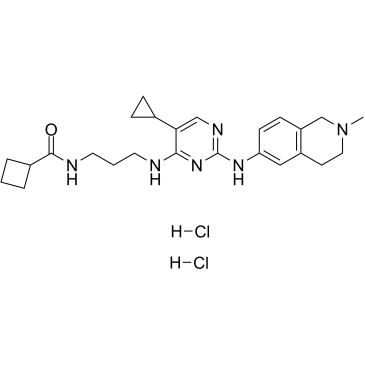| Cas No.: | 2080306-21-2 |
| Chemical Name: | MRT-68921 HCl |
| Synonyms: | MRT68921 HCl; MRT68921 hydrochloride; MRT68921; MRT 68921; MRT-68921. |
| SMILES: | [H]Cl.O=C(C1CCC1)NCCCNC2=NC(NC3=CC4=C(CN(C)CC4)C=C3)=NC=C2C5CC5.[H]Cl |
| Formula: | C25H36Cl2N6O |
| M.Wt: | 507.5 |
| Purity: | >98% |
| Sotrage: | 2 years -20°C Powder, 2 weeks4°C in DMSO,6 months-80°C in DMSO |
| Description: | MRT68921 hydrochloride is the most potent inhibitor of ULK1 and ULK2, with IC50 values of 2.9 nM and 1.1 nM, respectively. |
| In Vitro: | ULK1, a serine/threonine protein kinase, is essential for the initial stages of autophagy. MRT68921 inhibits ULK1 and ULK2 in vitro and block autophagy in cells. MRT68921 is the most potent inhibitor of both ULK1 and ULK2, with greater than a 15-fold reduction in the IC50 for ULK1 (2.9 nm) and greater than a 30-fold reduction for ULK2 (1.1 nm). Autophagy-inhibiting capacity of the compounds is specifically through ULK1. ULK1 inhibition results in accumulation of stalled early autophagosomal structures, indicating a role for ULK1 in the maturation of autophagosomes as well as initiation[1]. |
| Kinase Assay: | Kinase assays are carried out in 50 mM Tris-HCl, pH 7.4, 10 mM magnesium acetate, 0.1 mM EGTA, and 0.1% β-mercaptoethanol, containing 30 μM cold ATP, and 0.5 μCi of [γ-32P]ATP for 5 min at 25 °C. Prior to ATP addition, reaction mixes are pre-warmed to 25 °C for 5 min. Reactions are stopped by the addition of sample buffer, followed by SDS-PAGE, transfer to nitrocellulose, and analysis by autoradiography and immunoblot[1]. |
| Cell Assay: | MEFs and 293T cells are grown in DMEM, supplemented with 10% fetal bovine serum and penicillin/streptomycin, and cultured at 37°C, 5% CO2. For induction of autophagy, cells are typically grown to 75% confluency, ished twice, and incubated in Earle's balanced salt solution (EBSS) for 1 h (or complete medium as a control). MRT67307 (10 μM), MRT68921 (1 μM), AZD8055 (1 μM), or bafilomycin A1 (50 nM) is included[1]. |
| References: | [1]. Petherick KJ, et al. Pharmacological inhibition of ULK1 kinase blocks mammalian target of rapamycin (mTOR)-dependent autophagy. J Biol Chem. 2015 May 1;290(18):11376-83. |

 To enhance service speed and avoid tariff delays, we've opened a US warehouse. All US orders ship directly from our US facility.
To enhance service speed and avoid tariff delays, we've opened a US warehouse. All US orders ship directly from our US facility.




















